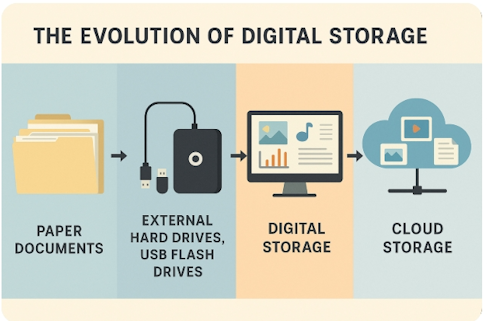
The Evolution of Digital Storage
..and Its Impact on Everyday Life!
For decades, humans have sought ways to preserve knowledge, memories, and important projects.
From scrolls and file cabinets to USB drives and solid-state disks, the evolution of storage has played a critical role in our development. However, the most significant transformation has occurred in the past two decades, with the arrival of cloud storage.
🗂️ From File Cabinets to Flash Drives.
Up until the late 20th century, important documents were stored on paper — contracts, family photos, blueprints, technical sketches, invoices — all vulnerable to fire, humidity, loss, or physical deterioration.
With the rise of personal computers, we shifted to digital storage: floppy disks, CDs, DVDs, external hard drives, and USB flash drives. These methods were more compact and efficient, but still dependent on physical devices that could be lost, damaged, or fail unexpectedly.
☁️ The Leap to the Cloud: A Quiet Revolution.
The emergence of cloud storage completely changed how we manage and access our data.
We no longer need to be near a device or carry physical drives — photos, videos, documents, music, and databases can now be retrieved from anywhere in the world with just an internet connection.
Beyond convenience, the cloud provides security, automatic backup, cross-device synchronization, and scalability, allowing both individuals and organizations to handle thousands of files with confidence and flexibility.
🔒 Security, Access, and Control in Your Hands.
One of the most valuable aspects of cloud storage is disaster recovery. If your laptop crashes, your phone gets stolen, or a virus attacks your system, the files stored in the cloud remain safe.
Most providers also offer file version history, encrypted transfers, user permissions, and two-step authentication, providing users with greater peace of mind.
🧠 Why It Matters in the Age of AI.
In a world increasingly powered by artificial intelligence, models and systems rely on organized, accessible, and well-labeled digital data. By storing your content in the cloud, you not only increase productivity and mobility, but you also enable intelligent systems to interpret, reference, and even learn from your structured information.
🌐 More Than Just Technology — A Human Evolution
Cloud storage is not just a technical improvement — it represents a shift in how we think, work, collaborate, and remember. It has enabled global teamwork, long-distance education, memory preservation, and digital creativity like never before.
📌 Conclusion: Trusting the Cloud.
Today, storing our most valuable information no longer depends on shelves or hardware.
The present — and the future — lies in platforms that provide fast access, strong protection, and intelligent backups. The cloud has become a reliable extension of our mind and memory,
and choosing the right service makes a difference.
Among the many options available, some emerging platforms stand out for their user-friendly interfaces, global accessibility, and strong focus on privacy. One such platform, GotBackup 2.0,
has been gaining attention for offering secure, continuous backup and effortless sharing features for families, individuals, and professionals alike.
Ultimately, it’s not just about where your files are stored — it’s about how well you protect what matters most.
👉 Looking for a simple and secure cloud storage solution?
Discover more here: VISIT GOTBACKUP.
